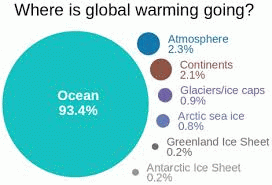Global warming is an apt description for the unambiguous rise in average Earth temperatures witnessed since 1971.
The most recent report of the International Panel on Climate Change says it is extremely likely that human influence has been the dominant cause of this warming which is driven by the build up of carbon dioxide emissions from fossil fuel combustion, cement production, and land use changes.
Atmospheric carbon dioxide build up produces a greenhouse effect that re-radiates some of the thermal wave lengths from the Earth's surface, which would otherwise escape into space, back towards the surface and the lower atmosphere leading to the increase in average surface temperatures.
Adding it all up, scientists estimate the total amount of heat warming the oceans, land, and atmosphere and melting the ice is the equivalent of four Hiroshima atomic bombs worth every second.
The planet is a big place. The extent of damage all of this heat does depends on where the warming occurs.

Where is global warming going?
(Image by components of global warming for the period 1993 to 2003 calculated from IPCC AR4 5.2.2.3.) Details DMCA
Currently about 90 percent is taking place in the oceans where the primary consequence is sea level rise due to thermal expansion and potentially more powerful and frequent tropical storms.
The 2012 paper, World Ocean Heat Content and Thermosteric Sea Level change (0-2000 m),1955-2010, by Levitus et al. points to the fact that over the study's span, to a depth of 2000 meters, the oceans have warmed by an average of 0.09 C.
Their average depth is over twice that at 4267 meters.
The Levitus paper indicates that if all of that seemingly small increment of heat was instantly transferred to the lower 10 kilometers of the atmosphere, it would warm on average 36oC, which would spell our demise and that of most other species.
Fortunately that release of heat won't happen anytime soon. By most estimates it will take 1000 years from the time we stop adding carbon dioxide to the atmosphere for the oceans and the atmosphere to come into equilibrium. That locks global warming in for an extended period but permits the equilibration between the atmosphere and the ocean to occur at a sustainable pace.
The oceans are huge and can trap huge amounts of heat for decades or even centuries.
Mostly that heat has gone into the upper layer to date; mostly to a depth of 700 meters although increasingly it is being measured below that.
The atmospheric surface temperature record since 1997 has essentially remained flat even as the level of carbon dioxide in the atmosphere has risen. Some have construed this as evidence of a pause in global warming or a hiatus.
Matthew England of the University of New South Wales however has affirmed that: "Global warming has not stopped. People should understand that the planet is a closed system. As we increase our emissions of greenhouse gases, the fundamental thermal dynamics tells us we have added heat into the system. Once it's trapped, it can go to a myriad of places - land surface, oceans, ice shelves, ice sheets, glaciers for example."
In his recently published study in the journal Nature , Temperatures blown off course, he explains how unprecedented trade winds have shifted heat into the ocean thermocline - between 100 metres and 300 metres - and that this is the primary cause of the global warming pause.
(Note: You can view every article as one long page if you sign up as an Advocate Member, or higher).





